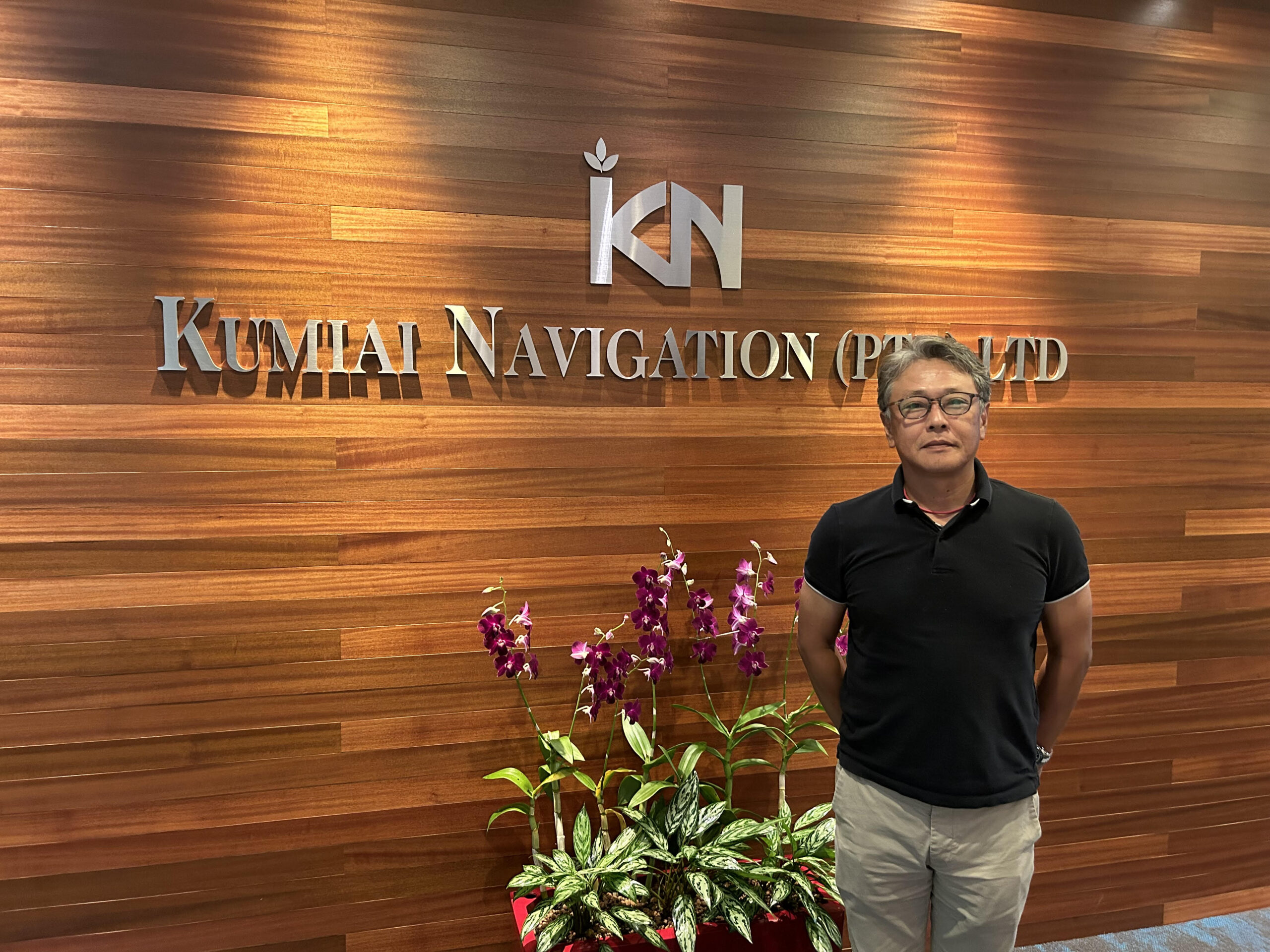Kumi AI Navigation, a Singapore ship owner, has overcome hardships and challenges over the past 28 years. MD Kuroyanagi: “Building the Third Pillar
Kumiai Navigation was established in Singapore in April 1995 as a wholly owned subsidiary of Kumiai Senpaku (headquartered in Tokyo). The company currently owns and operates 10 bulkers, 10 VLGC (large LPG (liquefied petroleum gas) vessels (3 on order), and 2 high-pressure LPG vessels. Tomomaru Kuroyanagi, 58, managing director of Kumiai Navi, has been a resident of Singapore since the company’s establishment and has overcome many rough patches as a Japanese-owned shipowner.

Why Singapore?
Singapore is now well known as a hub for shipping, but in the 1990s, it was still not well known. Nevertheless, we chose Singapore because of the country’s thorough support for the shipping industry,” Kuroyanagi said.
“I was assigned to Singapore on a company mission, not knowing what was right or left. I had to do everything from registration, to setting up an office, to hiring staff, all from scratch, but every time I did it, I felt the support of the Singaporean government and the MPA (Maritime Authority of Singapore). They would say, ‘You want to borrow money, then I will introduce you to this bank. I can only be thankful that Singapore’s national support for shipping has made it possible for us to continue our business as a Japanese-owned shipowner to this point.”
Kumiai Senpaku has been specialized in owning LPG carriers since the 1980s. When Kumiai Navi was established in Singapore, six vessels were transferred as an investment in kind. Even today, Kumiai Navi is unique among Japanese shipowners in owning VLGC vessels.
■The Spirit to Always Take on Challenges
At present, the company has a total of 10 VLGC vessels, including three vessels on order. The breakdown is six vessels with dual-fuel engines and four with fuel-oil-fired engines. We have been ordering and building VLGCs with the intention of taking on new challenges at any time. The presence of shippers, who charter our vessels, is also important to us,” said Mr. Kuroyanagi.
In fact, Kumiai Navi’s VLGC has concluded time charters with Norwegian major Equinor, Canadian energy giant AltaGas, and others. Because the shippers are charterers, “we have a very strong sense of security, and I think we are able to show our unique characteristics as a Japanese-affiliated shipowner,” says Mr. Kuroyanagi.
Absolute Confidence in the Quality of Management and Safe Operation
This is not to say that there have not been times of hardship.
The Lehman Shock (September 2008) caused the dry market to plummet. It was a silver lining for Kumiai Navi, which operates 10 vessels ranging from handysize to capesize vessels.
We could not charge charter fees if the charterer went bankrupt. We did everything we could, but we had no choice but to change charterers. The capital cost of bulk carriers at the time was high, but we overcame the crisis and learned a great lesson from it.
As a Japanese-affiliated shipowner in Singapore, which has preferential shipping tax treatment, there is no need for a sale and leaseback (S&LB, re-hire after sale). Above all, he does not want to be on the receiving end of so-called “off-balance sheet” charters, in which shipping companies do not record assets and liabilities on their balance sheets.
He said, “I have been an independent shipowner in Singapore with a lot of hard work. Although I do not manage my own vessels, I am confident in the quality of management and safe operation, as one-third of my staff is technical staff. Japanese shipping companies are important customers. That is why we want to show that we are willing to find time charter contracts on our own. We do not feel the need to do off-balance or bareboat (BBC) projects,” said Kuroyanagi.
Seeking a new type of vessel to follow VLGC and BC
Currently, 70% of the company’s vessels are chartered overseas and 30% in Japan. The company wants to work with professional operators (ship operators), both in Japan and overseas.
The company’s future challenge is to establish a “third pillar” following VLGC and bulk carriers. The company is also looking at owning tankers.
One of the advantages of having a base in Singapore is its human resources.
Deputy General Manager Yuto Tanaka, who has been with the company for 13 years, joined Kumiai Navi as a new graduate after graduating from university.
Mr. Tanaka says, “I always wanted to work overseas.
I had always wanted to work overseas. I was introduced to Kuroyanagi because my father worked for a shipbuilding company. I was told that I would be hired locally, but I had no hesitation at all.
He is now an indispensable part of Kumiai Navi, negotiating with Equinor in Norway and making business trips to Canada.
■Japanese students also look at Japan from the outside
Mr. Kuroyanagi is not so pessimistic about the state of Japan’s youth these days.
Most students start job hunting in their third year of university,” he said. Most students start job hunting in their third year of university,” he said. However, now and in the past, there are always young people who have the spirit of challenge and want to go abroad to work. Singaporean students are excellent, but they also have a dry side. I would like Japanese students to go abroad and experience seeing Japan from the outside.
Although he originally graduated from Tokyo University of Mercantile Marine (now Tokyo University of Marine Science and Technology) as a seaman, he says with a laugh, “I was on a ship for only one year. He is proud to have been in charge of Singapore’s shipping business for a total of 28 years.